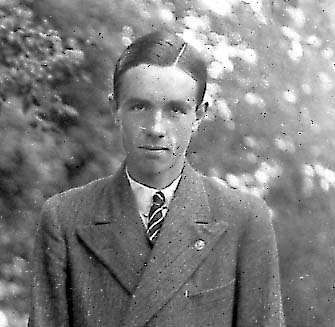Born : December 30, 1912
Died : March 30, 2001
Author : Michael T.R.B. Turnbull
Influential And Gifted Musician And Witness To Loch Ness Monster

Born in London, the son of a fishmonger, James Brusey was educated at Fort Augustus Abbey School. A contemporary, Monsignor John Barry, remembers him as a fine cricketer, the best slip fielder in the school. However, it was as a musician that James was best known. Inspired by his teacher, Father Luke Cary Elwes, he became a fine pianist and organist and a competent violinist.
In 1931 he left the Abbey School and entered the novitiate at Fort Augustus. A year later he was professed a monk as Brother Gregory. Towards the end of 1932, he and three other young monks were sent to St Andrew’s Priory School in Edinburgh partly to help with the school but primarily to study at Edinburgh University. He matriculated and began his studies in the department of music where the composer Professor Donald Tovey recognised Brother Gregory’s fine technique and musicianship.
Graduating in 1938, he set off from Fort Augustus to Budapest where, based at the Benedictine monastery of Pannonhalma, he spent a year studying theology and the organ at a conservatoire.
The following year he returned to Fort Augustus and, after completing further studies, was ordained a priest on August 10, 1941. Over the next years Father Gregory taught music at Fort Augustus, to which St Andrew’s Priory School had now been evacuated. There, he assisted the pianist and composer Wilfred Worden, also taking an active part in productions of Gilbert and Sullivan.
However, his forte was the magnificent abbey organ, brought to Fort Augustus in 1894.
Abbot Sir David Oswald Hunter Blair recalled that the presence of the mighty organ, with its hundreds of pipes, had its own special hazards before the instrument was finally assembled in all its glory: “One pipe alone, the mighty 32ft-cylinder, had to be left in all its length in the cloister, close to where we assembled for the daily offices; and there, one summer evening, was heard an indescribably confused sound of scratching and squeaking. Could it be – surely not – yet it was, a small boy who had crawled head first into the mighty open tube, with the firm purpose of emerging at the other end. Alas! He found himself in a cul-de-sac, and nearly smothered; and only with incredible struggling, scrabbling, panting, and groaning was he extricated backwards, but alive, from his perilous position.”
This was the magnificent instrument with which Father Gregory astounded tourists and uplifted all who heard him play the great organ compositions of Bach, Pachelbel, and the more popular works of Widor.
During the war, members of the Fort Augustus community did what they could to supplement food supplies.Brother Joseph scrounged sugar to keep his hives of bees alive; Father Gregory, an avid fisherman, spent cold and weary hours out after salmon on Loch Ness in snow, sleet, and rain.
After the war, Father Gregory was appointed master of music at the newly opened Carlekemp Priory School in North Berwick, East Lothian, overlooking the golf courses, a hundred yards from the Firth of Forth. Father Gregory encouraged the formation of a recorder group, while also successfully presenting boys for the Royal Academy of Music piano examinations.
Father Gregory, with his gregarious nature and friendly smile, not only taught music but was an enthusiastic Cubmaster. Every Saturday afternoon the Cub pack met, using the woods in the school grounds for happy hunting, often puzzling passing golfers with their enthusiastic howls and other animal noises.
During the 1950s, under Abbot Oswald Eaves, Father Gregory took part in the first full-length service broadcast from Fort Augustus Abbey – Vespers of the Feast of the Sacred Heart. This was followed by several radio and television broadcasts, all of which served to highlight the work of the monastery and school and its special place in Scottish heritage and tourism.
Over the following years, Father Gregory also taught music at the Abbey School, Fort Augustus. He led the brass band, helped with the choral society, and continued to play the abbey organ for services and tourists, filling the great space of the Abbey Church with the overwhelming power of the organ.
Father Gregory had one other claim to fame. In 1971 he featured on a television programme broadcast about the Loch Ness monster. He had now become one of the most prominent witnesses to the existence of the monster, which he had suddenly seen while he was walking in the monastery garden. But he had decided views about Nessie. In the New York Times he was quoted as saying: “We ought to leave the monster alone. In this technological age, we’ve placed a label on everything. I am a champion of the unknown. Mystery intrigues people, and so it should remain.”
In 1999, following the departure of the Benedictine Order from Fort Augustus, Father Gregory, by this time profoundly deaf, his hands crippled with arthritis, took up residence at Ampleforth Abbey near York. With his wonderfully easy and generous way with people, he maintained a wide circle of friends. He died peacefully, in the company of his fellow monks. He leaves a sister, Genevieve, and a brother, Percy.
